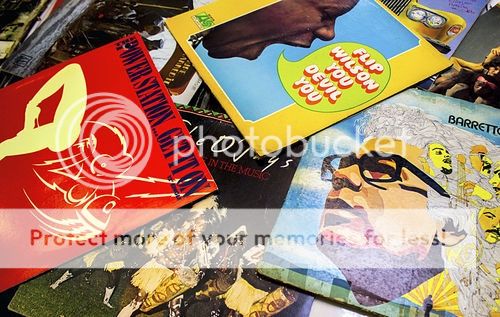Endless rows of brand-new white cardboard boxes stacked chest-high greet you as you walk into Gavin Brown’s Enterprise, a posh art gallery on Greenwich. An amber-haired archivist in his early 30s gingerly scans the contents of one the boxes, fishes out a vinyl record, and hands it to me. It’s a dog-eared and dusty copy of the Shaft in Africa soundtrack, the last in the trilogy of films, largely forgettable in comparison to its ubiquitous, self-titled progenitor. I hand the record back, and he collates it into one of the neat piles of records spread out across the makeshift tables.
Sorting through stacks of vinyl is usually an activity reserved for Sunday garage sales and the Luddite havens of record stores, not West Village galleries. But this isn’t a normal record collection; this is the record collection that invented hip-hop. This is Afrika Bambaataa’s 40,000-strong collection of wax that serves as a tactile evolution of a singular genre of music. One that traces the steps from the Bronx-bred DJing of breaks before hip-hop even existed to the earliest incarnation of the genre and well beyond.
“It’s literally the history of hip-hop unfolding itself in front of your very eyes through vinyl artifacts,” says archivist and curator Johan Kugelberg. Kugelberg spearheaded the Cornell University Library Hip-Hop Collection, the largest gathering of items documenting the birth of hip-hop in New York City and its expansion around the globe.
Last summer, Bambaataa was appointed to a three-year term as a visiting scholar at the university after an impressive symposium appearance. “I liked the atmosphere and the interaction with the people, and [library administrators] liked what I was saying at the panel, and when I was speaking to one of the classes, so they decided to bring me there for this, and I said, ‘No problem,'” he told the Village Voice back in November.
After mulling it over for some time, he decided that his life’s work was best stored where it will be both enjoyed and utilized for teaching future generations. “Under careful supervision, we have emptied three of Bambaataa’s storage spaces and literally a field excavation,” Kugelberg says. “Identifying anything from documents with scripts to old tapes to Soulsonic Force costumes, you know, the whole thing. All of this needs to be inventoried and identified before it goes to Cornell. The record collection is arguably the single most important component of it because it is the history of hip-hop culture in sound being gathered by, in my opinion, the most important person in the history of hip-hop.”
Widely considered one of the first breakbeat DJs—extending a drum-laden break in a record by switching back and forth between multiple copies of the same record on opposing turntables—Bambaataa was instrumental as a precursor to hip-hop. The songs he played during his countless block parties shaped the genre. “He was the master of records before hip-hop was even hip-hop. He has always been, arguably, the most adventurous in hip-hop,” says Kugelberg.
Bambaataa is, of course, famously credited with coining the term “hip-hop” in a 1982 Village Voice article.
Born and raised in the then seemingly lawless South Bronx of the ’60s, Bambaataa (born Kevin Donovan) spent time as a member of the Black Spades gang before winning an essay competition that changed the trajectory of his life. Awarded with a trip to Africa, the young man found himself, and with eyes open, came home determined to forge peace in a community where violence and malcontent had played out as the standard. He took the name Afrika Bambaataa Aasim in honor of a Zulu chief who had fought an armed rebellion against injustice.
Bambaataa began DJing hip-hop parties in an effort to lure the disenfranchised and downtrodden away from gangs, in an attempt to wage peace. He recruited a wide berth of creative and dynamic talent reaching far beyond simply music. He gave a home to socially and politically conscious graffiti artists, B-boys, DJs, and MCs alike. It was the birth of the Universal Zulu Nation, and it didn’t take long before Bambaataa snowballed his group of like-minded conspirators into a creative juggernaut that would burst from the Bronx and spread across the five boroughs like wildfire.
The block parties and dances they organized at local gymnasiums were the stuff of hip-hop lore. DJ Kool Herc and Jazzy Jay would play their new burgeoning music on vinyl alongside Bambaataa; eventually, the new and exciting sound would head south to explore new audiences found in Manhattan’s nightclubs.
When Afrika Bambaataa and the Soulsonic Force released the Kraftwerk-inspired “Planet Rock” in 1982, the sounds of electro filtered through the airwaves at an unstoppable pace. A synth-heavy mixture of hip-hop sensibilities with 808 drum machines changed the game. It was new and stimulating and largely introduced the world to Bambaataa.
Thirty-one years later, he might be the only person to count both James Brown and John Lydon of the Sex Pistols as collaborators, perhaps a testament to his influential status amongst the iconoclasts. Bambaataa’s reputation as the godfather of the genre is unquestionable. He hasn’t slowed down, either, continuing to DJ around the globe, spreading his message of peace, love, and unity. During those years, he also collected and cultivated a gargantuan record collection that has come to represent the Magna Carta of hip-hop.
“It’s totally crazy,” says Kugelberg with excitement. “Even now while we’re skimming the surface, I’m seeing the most insane stuff. I’m getting daily e-mails from people like DJ Shadow going, ‘What the hell is wrong with me? Why can’t I be there?’
“It’s 40,000 records that need to be entered into spreadsheets. Does it have comments? Does it have a press release? Is it signed by the artist? Is it a test pressing or acetate? We have some duplication in the collection. And those vinyl records need to be digitized, stabilized, inventoried, and all that kind of stuff.”
To explain the magnitude of such work and the manpower it will entail, Kugelberg and his handful of archivists are planning on spending five hours a day, five days a week for an entire month to properly work their way through the collection, and are opening the process up to the public.
“Gavin [Brown] and I were talking about how cool it was when we could go to the Natural History Museum or the Met or something like that and see active research and organizing taking place in front of our very eyes,” says Kugelberg. “Since this is arguably the most important record collection in the history of hip-hop, we figured the public should be able to come and see it at work.”
So that’s exactly what they’ve set out to do: perform a public archiving that gives anyone and everyone a chance to see Bambaataa’s collection and the efforts to preserve it in person before it heads to its permanent home at the Cornell University Library. Instead of dusting off dinosaur bones or Paleolithic pottery, you can see the stepping stones of rap.
The gallery also plans on inviting a number of DJs to come through and perform, utilizing only the collection, which is wildly diverse—everything from reggae and Latin jazz to The Carpenters and Elvis.
“This gathering of 40,000 records is so extraordinarily multifaceted. I got goosebumps when I found Bambaataa’s copy of Trans Europe Express with an ownership signature on it. It’s really, really important stuff that’s not going to cease to be important 200 years from now,” says Kugelberg.
It’s maybe safe to assume that, 200 years from now, people won’t even know what vinyl records are or how they’re played. They will know Bambaataa, though. He and his collection are timeless.
Afrika Bambaataa’s record collection will be on display at Gavin Brown’s Enterprise (620 Greenwich Street) Monday through Friday from noon to 5 p.m. until August 10.
DOWNLOAD ON DMS



